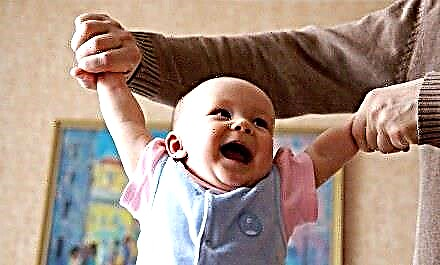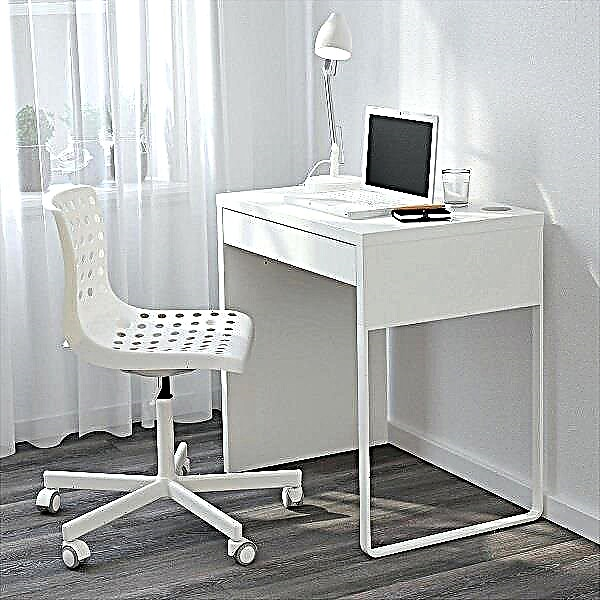In the first week of life, crumbs, newly-made mothers feel fear of a newborn, do not know how to behave with him, how to handle the umbilical cord, how to feed, bathe, and dress. However, a little dad's help and mom's reliable instincts will quickly make caring for a baby natural. Simple recommendations of pediatricians will avoid mistakes when caring for children.

Parents take care of the baby
Newborn care checklist
Children's furniture and household items form the basis of proper childcare. Products should be comfortable and functional, making it easier for parents the first months of life with their baby. A basic list of items should include:
- crib;
- changing table top for a chest of drawers or a separate table;
- children's wardrobe;
- a stroller;
- polymer bath;
- car seat (if there is transport);
- thermometers for measuring the temperature of water, air, body.
Clothes should be chosen from natural fabrics, the minimum size (50-56). The child will need the following wardrobe items:
- 10 flannel, calico diapers each;
- 3 undershirts from cotton, flannel;
- 2 pants, sliders;
- 3 cotton hats;
- scratches;
- 3 pairs of socks;
- bodysuit;
- slips.
In the cold season, you will need warm things: a warmed flannel blanket, an envelope.
Among the hygiene products, you should choose products from proven brands that have a gentle effect:
- diapers;
- ear sticks;
- wet wipes;
- detergents, detergents;
- powder for leather treatment;
- baby lotion.
A first aid kit for an infant should be collected with the permission of the pediatrician. Mandatory are potassium permanganate, brilliant green, anti-colic drugs, antipyretics.
Note! The daily necessities are inexpensive individually, but the purchases are a decent amount for middle-income families. Things should be bought in stages, several months before being sent to the maternity hospital.

Preparation of things in the hospital
Recommendations for the treatment of a newborn
How to treat a newborn from the first days of life? Overview of comfortable conditions for child adaptation:
- At the first stage of life, the child does not hold his head, his bones are fragile, muscles are weak. Parents should take special care when handling the baby, support this part of the body at the time of motion sickness, bathing.
- Disposable diapers should be used if there are no allergies. During the day, the child's skin must breathe, it is advisable to arrange air baths lasting 10-15 minutes 3-4 times / day.
- The wardrobe for the newborn matches the wardrobe of the mother. High probability of overheating. In a dream, it is enough to cover the baby with a thin fleece blanket or a warm diaper.
- 2-3 weeks after birth (in the summer of 1 week), the baby is taken out into the fresh air. In winter, the first walks last 10 minutes; in summer, the baby should spend 5-6 hours daily in the fresh air.
Important! For a born person, the care and attention of parents is important. The fontanelle at the top of the skull is tightly covered with skin. Light stroking of the head will not harm the baby.
In the maternity hospital
When the child is in the hospital, he will undergo a daily examination by a neonatologist. The doctor will agree on the main manipulations, appointments with the young mother, he will tell about the results of the examination. For more information about caring for a child or external signs of an illness (for example, a red spot on the face), you should correctly formulate the question, the doctor will give a detailed answer on what is done with the child immediately after birth.
If necessary, the baby will be examined by an ophthalmologist, a neurologist. The baby will be determined by the blood group and Rh factor, routine tests will be performed or additional procedures will be prescribed: blood tests, urine tests, neurosonography, echocardiography. The first vaccinations are also carried out in the maternity hospital: on the first day - against hepatitis B, on the second - against lung disease.
Important! The baby in the hospital is under constant supervision. The main task of a newly-made mother is to be active, to ask doctors how to behave with a newborn baby, to ensure maximum hygiene, and to establish breastfeeding.

Stay in the hospital
Upon discharge from the maternity hospital, the mother will receive two parts of the exchange card. The parent sends the document containing information about childbirth to the antenatal clinic. The second card containing information about the child is taken to the children's clinic. The next day after discharge from the hospital, the mother and her baby will visit the local doctor with a nurse.
Houses
What to do with a newborn baby after the hospital, basic rules:
- ensure maximum cleanliness in the house;
- take care of daily hygiene procedures;
- reduce the number of relatives or friends staying in the child's room (the baby's immune system must initially adapt to the immediate environment);
- change linen daily, boil, iron on both sides;
- identify conditions that make it necessary to seek help from a medical facility.
Caring for a baby requires scrupulousness and attention from adults, certain knowledge and skills.
After discharge from the hospital, parents need to bathe the child or wash it with clean water. The second option is provided for the presence of BCG-M vaccination. The bathing water is boiled until the umbilical wound heals. Duration of hygiene procedures - 5 minutes, water temperature - +36 ° С. It is important to prevent water from entering the nose and mouth. Upon completion of bathing, the baby is poured with water 0.5-1 degrees cooler than the liquid in the bath. Then the baby's skin is dried (do not wipe it!) With a towel or cotton cloth with a blotting motion.
Umbilical cord processing
Correct handling of the umbilical cord implies providing the umbilical cord with air access, preventing the penetration of urine, fat, it is necessary to rinse the appendix with water in case of contamination. You should also exclude the use of lotions, antiseptics, powder for its processing.
In a clean dry state, the process falls off on its own for 5-15 days. The remaining wound is treated twice / day until complete healing. With two fingers of the left hand, the navel is pushed apart, with the right hand they dip it with a cotton swab dipped in hydrogen peroxide. With dry cotton wool, the skin is covered with a brilliant green solution (a few drops are enough).

Processing of the umbilical cord
Daily mucous membrane and skin care
The baby is placed on the changing table, the skin, folds, mouth, nose, eyes and nails are examined. Dry parts of the body require care with baby cream, oil, milk.
Attention! It is impossible to sprinkle the same parts of the body with powder and smear with cream. The powder prevents rubbing of the skin with a diaper or clothes, the composition is applied to dry skin, after rubbing the lumps in the hands.
It is convenient to cut baby's nails while sleeping with scissors with rounded ends. It is not safe to cut nails "at the root". Children's pedicure is formed evenly, manicure - by rounding the corners.
The eyes are cleaned with moist sterile cotton wool from the outer corner to the inner edge with separate tampons. To avoid water entering the second eye, the child is placed alternately on the right and left side.
The baby's nose is cleared by sneezing. If there are no signs of congestion, shortness of breath, then no care is required. Otherwise, the flagellum, moistened with boiled water, is carefully screwed into the baby's nose, the crusts are removed. There is no need to clean the ears in the first month of a newborn's life. After urinating and defecating, the baby is washed with running water from the pubis to the ass.
Council. It will be convenient for the child to stay awake, relax, walk and swim according to the schedule worked out by the parents with the pediatrician.
Feeding in the first days of a child's life
The first week after childbirth is a crucial period in the development of lactation. It is important to take into account the peculiarities of behavior under the breast of the baby and the tasks of the mother.
First day of life
For the first time, the baby is applied to the breast for two hours after birth. Normally, at 15-20 minutes of life, the crumbs develop search reflexes: raising the head, turning it to the sides and smacking its tongue. The mother's task is to give the baby a comfortable position at the breast, to help grab the nipple deeper. The index and thumb of the hand feeding the breast should be in a position parallel to the baby's lips and form a fold that is comfortable for the baby to grip.

Baby's first lactation
The duration of the application is at least 5 minutes. If lactation is accompanied by unpleasant sensations in the nipple or lasts more than 10 minutes, you must carefully place your finger in the corner of the baby's mouth, open the gums, and take out the breast with the other hand. Then it is recommended to attach the baby to the second breast. After the first lactation, the baby will sleep for 2-6 hours.
With regular feeding (once every 3 hours), a little girl or boy receives 10 ml of colostrum per day. If the baby skips feeding, the mother is forced to stimulate the breast by pumping, to supplement with the resulting milk after sleeping and the next latch on to the breast.
Second day of life
Attachments become more frequent and prolonged. Children respond more actively to the discomfort caused by a bowel movement. Colostrum acts as a mild laxative and promotes the release of meconium. Regular bowel movements, anhydrous environment provoke a decrease in the baby's weight by 7-10%. Mothers need to monitor the compliance of weight with the norm, monitor the readiness of a barely born girl or boy to feed and the productivity of lactation.
Third to fifth day
On the third day, colostrum is replaced by a large volume of transitional milk. The breasts are filled, the density of the mammary glands increases. It is important for the mother to avoid coarsening of the breasts by applying the baby on demand. 30-40 ml of milk is allocated one time. Both breasts should be offered at one feeding, alternating between them.
Newborn baby's first bath
At birth, the child's body adapts to the external environment, it is recommended to bathe the baby as the navel heals. The baby is laid on his hand with his stomach down, little by little water is poured onto his back, covering the navel with his palm. A child in the water should feel as comfortable as possible. Initially, feet are placed under the stream of water. If the baby reacted positively, you can start pouring water over the body.
When the umbilical wound has healed, the child is ready to bathe in the tub in running water. It is no longer necessary to boil water. It is enough to rinse the bath before water procedures with baking soda or soapy water, rinse with boiling water. The optimum water temperature for bathing babies is 36 ° C for 5 minutes. Baby soap will provide proper care for your baby's skin.

Baby bathing
What not to do with a newborn
The experience of motherhood will be initially correct, positive, if you follow the simple advice of pediatricians:
- It is advisable for children under six months of age to sleep separately from the slave parents. The measure reduces the risk of injury.
- Shaking will harm the baby. Cuddling and hugging are the best ways to calm your baby while keeping them warm and safe.
- It is not recommended to give water to babies up to 6 months old, even in hot weather. Water provokes diarrhea and malnutrition in babies.
- You should not put your child to sleep on his back. In the first half of life, babies are prone to regurgitation.
- There is no need to salt food. Baby's underdeveloped receptors do not recognize salty taste.
- The child must be supervised in the bathroom.
- It is advisable to change diapers every 2-3 hours. Overfilled hygiene products stop absorbing liquid and begin to put pressure on the child. Feces not absorbed into the diaper irritate the baby's skin.
- Walking in crowded places will harm the baby. Birth for a newborn is a heavy ore, a huge stress. The child needs an adaptation period.

Autumn walks with a baby
Having secured useful advice, step-by-step instructions from specialists, do not forget about your own intuition. If the inner voice conflicts with the opinion of the majority, it is important to approach decision-making responsibly.



